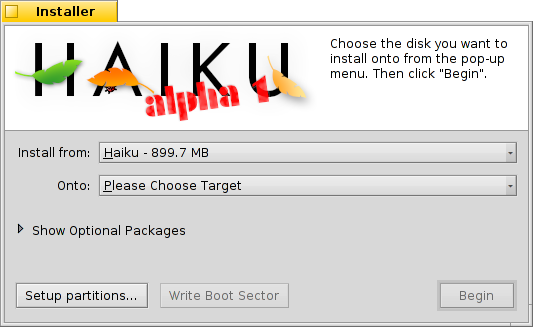 Installer
Installer
| Deskbar: | No entry. Has to be started from /boot/system/apps/. | |
| Location: | /boot/system/apps/Installer | |
| Settings: | none |
The Installer is used to copy Haiku onto another volume. Upon launch it displays a start window with important information. It's not a mindless EULA you're used to click away in the blink of an eye, it states:
This is alpha-quality software. Make backups or suffer the consequences!
The Installer needs a prepared partition. You may have to use a GParted LiveCD or a similar tool until Haiku's DriveSetup is mature enough to handle this task.
Haiku can be added manually to the bootmanager GRUB. In short, you have add an entry to /boot/grub/menu.lst of your Linux installation, similar to this:
# Haiku on /dev/sda7 title Haiku rootnoverify (hd0,6) chainloader +1
Once you acknowledged with , you're presented with the main window:

In the first drop-down menu you choose the source for the installation. It can be a currently installed Haiku or can come from an install CD or USB drive, etc.
The second drop-down menu specifies the target for the installation. This target partition/volume will be completely overwritten and has to be set aside beforehand by a partitioning tool like GParted.
Clicking the little expander widget will Show Optional Packages, if available, that you can choose to install in addition to the basic Haiku.
You should do a last check if you really picked the right target before starting the installation process. Click on to open DriveSetup and have a look at the naming and layout of the available volumes and partitions.
starts the installation procedure, which basically copies everything but the home/ and common/ folder onto the target volume.
If you don't use a bootmanager like GRUB, where you can add Haiku (see start window), you can use the button to make it bootable directly.
